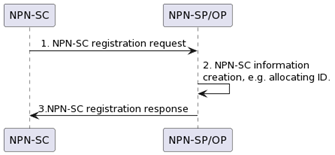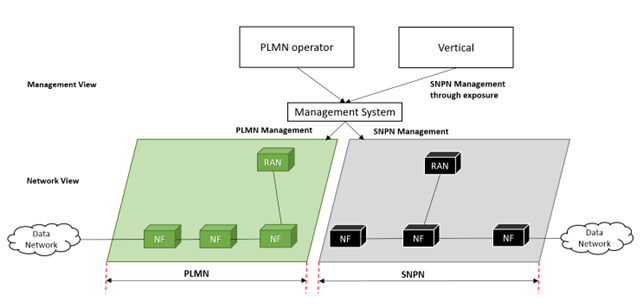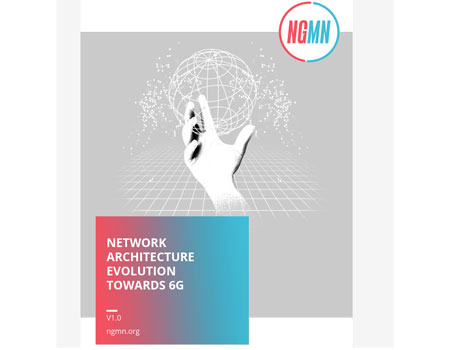By WG SA5 - Author Kai ZHANG (Huawei)
The management of non-public networks (NPN) in 3GPP has been introduced in 3GPP Release 17.
3GPP SA5 has focused on the basic management and orchestration aspects of NPN. The fundamental concepts, management modes, roles related to NPN management and some basic solutions mainly including provisioning of SNPN and PNI-NPN are captured in 3GPP TS 28.557 [1].
To support enhanced management of NPN in 3GPP Release 18, 3GPP SA5 has launched a study on enhancement of management of non-public networks.
This article addresses key technical aspects of management of NPN including:
- E2E fault management
- Management of NPN service customer
- Resource isolation demand for Smart Grid Utilities
- SLA monitoring and evaluation
- Exposure of management capabilities and corresponding managed resources under MNO-Vertical Managed Mode
- Moving forward in Rel-18
E2E fault management
In some vertical scenarios, 5G industry terminal, e.g. camera, programmable logic controller (PLC) and Smart Distribution Transformer Terminal and so on, are widely deployed. These large quantity 5G industry terminals which may be provided by multiple vendors are managed by multiple standalone terminal management systems and this increases the complexity and difficulty of NPN management, especially for E2E fault location. For example, if an NPN goes down, it is difficult to locate rapidly where the fault occurred or to determine whether the fault is caused by the industry terminal.
5G-ACIA has described the functional requirements for exposing the capabilities of non-public 5G systems to industrial factory applications in a white paper (see Exposure of 5G Capabilities for Connected Industries and Automation Applications) [2]. The requirements given in clause 4.3 of 5G-ACIA white paper in [2] are aspects of network management, as following:
"[R-4.3.1-07] The 5G exposure reference points must allow monitoring of errors and other alarms from physical/logical network components and connections.
[R-4.3.1-08] The 5G exposure reference points must provide the monitoring information in such a way that it can be effectively used for error detection, localization, root-cause analysis, and error resolution."
Therefore, for vertical industry scenarios, to provide solutions to support the use cases and requirements from 5G-ACIA, 3GPP management system needs to provide fault management capabilities scoping NPN and UEs representing 5G industry terminals. These capabilities need to be integrated with the ones scoping OT domain (non-3GPP domain), to allow for E2E fault location:
- For the fault management of NPN, the network alarm can be discovered by analysing performance data or network alarm event reporting. In this case, the generic fault supervision management service and performance assurance management service in clause 11 of TS 28.532 [4] can be re-used to collect the network performance data and alarm data. For network failure prediction, the MDA capability described in clause 7.2.3.1 of TS 28.104 [8] can be reused.
- For the fault management of 5G industry terminals deployed in an enterprise, the NPN management system should support to performance monitoring and fault diagnosis for 5G industry terminals. NPN management system can collect the performance data and then execute data analysis for alarm detection, localization and/or resolution. The performance data collected from industry terminal may include UL/DL throughput volume, UL/DL throughput time used for calculation of UL/DL throughput, UL/DL packet delay per QoS level, UL/DL packet loss rate per QoS level, etc., defined in clause 4.34.1 of TS 32.423 [9]. The trace control and configuration of MDT in clauses 4.1, 4.2 and 6 of TS 32.422 [5] can be reused for trace/UE measurements activation/deactivation and MDT report to collect MDT data from 5G industry terminals.
Management of NPN service customer
As description in TS 28.557 [1], an NPN service customer is used to represent the role of communication service customer in NPN environment. NPN service customer can request and consume the management capabilities exposed by the mobile network operator. The mobile network operator would restrict the types (e.g. provisioning, fault supervision, performance assurance) of management capabilities and corresponding managed network resource exposed to an NPN service customer.
An NPN is provided to a vertical (playing the role of NPN-SC) for private use. Before an NPN is created, an MNO (playing the role of NPN-SP/NPN-OP) needs to authenticate the vertical. If the authentication is passed, the MNO management system should manage the related information for NPN service customer, for example, allocating a new identity of the vertical which can be used in MNO management system and creating the context of the vertical to keep the new identity, authorized available management capabilities, required coverage area and so on.
3GPP SA5 has introduced the procedure of management of the related information for NPN service customer in TR 28.907.

Figure 1: Procedure of management of the related information for NPN service customer
The procedure of creating NPN-SC context information can be applied by NPN-SP/NPN-OP to restrict the management capabilities and corresponding managed network resources exposed to NPN-SC. The details of the context information can be managed in form of NRM IOCs and it is proposed in SA5 to continue this work in further normative work for Rel-18 to update the NRM IOCs in TS 28.541 [7].
Resource isolation demand for Smart Grid Utilities
Smart Grid is a representative utility with NPN. A power grid consists of four building blocks: power generation, transmission, distribution and consumption. These different phases require different services, and these services have distinct communication requirements.
NPN may be deployed to support the different use cases and service requirements for multiple Smart Grid applications. For example, multiple NPNs (e.g. multiple PNI-NPNs, each having on-prem NFs and a dedicated portion of PLMN NFs as a slice of the PLMN) may be deployed to meet the requirements of physical isolation communication service. The logical isolation communication service on the other hand may be supported by shared network element or shared network resource in one NPN for Smart Grid.
To satisfy the resource logical and/or physical isolation demand for Smart Grid Utilities, 3GPP SA5 introduces a resource isolation-sharing policy which contains the grouping information based on division of safety zones. It is proposed to use this as an input for the ongoing normative work network slicing provisioning rules in SA5 to discuss the normative solutions for Release 18.
SLA monitoring and evaluation
A service-level agreement (SLA) consists of a technical part and a non-technical part (i.e., pricing and billing conditions, penalties, etc.). The technical part, referred to as SLS, capture service requirements which are input to 3GPP management system. For example, TS 22.104 [3] presents service requirements of cyber-physical control applications (e.g. motion control, process automation, etc.) in vertical domains, which require very high levels of communication service availability and/or very low end-to-end latencies. The end-to-end latency is also very important for the applications of smart Grid, e.g. differential protection in power distribution grid.
From network management perspective, the network management service provider allocates network resource to provide communication service based on related service requirements, monitoring the network performance to evaluate the SLA fulfilment.

Figure 2: high level process for NPN SLA management
In figure 2, steps 1 to 3 describe the workflows of NPN creation or update which is specified as NPN provisioning procedures in TS 28.557 [1] in detail. The steps 4, 5 and 6 are the NPN SLS monitoring and SLA assurance loop.
The NPN management system (e.g. NPN-SP/NPN-OP/NEP) collects performance data (e.g. packet delay in TS 28.552 [6] and reliability in TS 28.541 [7]) to monitor the NPN status through performance assurance MnS. The typical categories of KPI include Accessibility, Integrity, Utilization, Retainability, Mobility, Energy Efficiency and Reliability as defined in TS 28.554 [11].
Based on the network KPIs, the NPN management system evaluates the network availability and reliability to assure the SLA fulfilment. If the SLA is not fulfilled, the NPN management system adopts some optimization methods to promote the network performance, such as SLA parameter coordination among RAN NEs, RAN resource and priority scheduling adjustment. For SLS fulfilment information monitoring, assurance closed control loop introduced in TS 28.536 [10] may be applied to achieve the SLS assurance control.
Exposure of management capabilities and corresponding managed resources under MNO-Vertical Managed Mode
TS 28.557 [1] specifies two management modes for PNI-NPN and three management modes for SNPN. Under MNO-Vertical Managed Mode for PNI-NPN and MNO-Vertical Managed Mode for SNPN, the vertical also plays the role of NPN operator shared with mobile network operator, to achieve management on the NPN served for the vertical. Therefore, a bundle of management capabilities and corresponding managed resources should be exposed to the vertical from the mobile network operator according to the business agreement between the two parties under MNO-Vertical Managed Mode.

Figure 3: Vertical managing PNI-NPN through exposure
Figure 3, as an example, illustrates how the PLMN operator and the vertical manage the PNI-NPN under the MNO-Vertical Managed Mode. The PNI-NPN, which is deployed across one PLMN and the vertical's premises (e.g. factory), can be seen as an end-to-end network composed of two differentiated segments: one public, consisting of a (R)AN and network functions built upon public 5GC network resources; and one private, consisting of network functions deployed using non-public 5G network resources. The vertical can realize the management of PNI-NPN through management capabilities exposure.

Figure 4: Vertical managing SNPN through exposure
Figure 4, as an example, illustrates how the PLMN operator and the vertical manage the SNPN under the MNO-Vertical Managed Mode. The SNPN is deployed as an independent, isolated network. All SNPN network elements are located inside the logical perimeter of the vertical's premises (e.g. factory) and the SNPN is separate from the PLMN. The PLMN operator and the vertical play the role of SNPN operator together, and the vertical can realize the management of SNPN through management capabilities exposure.
Moving forward in Rel-18
During Release 18, 3GPP SA5 will pursue its efforts in various directions above, to provide normative solutions for management of non-public networks.
Reference information
Management of non-public networks SID/WIDs in Rel-17 and Rel-18:
|
Release |
UID |
Work Item name |
Specification |
Acronym |
|
R17 |
870023 |
Management of non-public networks |
OAM_NPN |
|
|
R18 |
940035 |
Study on enhancement of management of non-public networks |
FS_OAM_eNPN |
Specification References
[1] 3GPP TS 28.557: "Management and orchestration; Management of Non-Public Networks (NPN); Stage 1 and stage 2".
[2] 5G-ACIA: Exposure of 5G Capabilities for Connected Industries and Automation Applications, https://5g-acia.org/wp-content/uploads/2021/04/5G-ACIA_Exposure_of_5G_Capabilities_Download-1.pdf
[3] 3GPP TS 22.104: "Service requirements for cyber-physical control applications in vertical domains".
[4] 3GPP TS 28.532: "Management and orchestration; Generic management services".
[5] 3GPP TS 32.422: "Telecommunication management; Subscriber and equipment trace: Trace control and configuration management "
[6] 3GPP TS 28.552: "Management and orchestration; 5G performance measurements".
[7] 3GPP TS 28.541: "Management and orchestration; 5G Network Resource Model (NRM); Stage 2 and stage 3".
[8] 3GPP TS 28.104: "Management and orchestration; Management Data Analytics (MDA)".
[9] 3GPP TS 32.423: "Telecommunication management; Subscriber and equipment trace; Trace data definition and management".
[10] 3GPP TS 28.536: "Management and orchestration; Management services for communication service assurance; Stage 2 and stage 3".
[11] 3GPP TS 28.554: "5G end to end Key Performance Indicators (KPI)".
Please be aware that this page is a snapshot of the work going on in 3GPP at the time of writing. The full up-to-date picture of all work is contained in the Work Plan (https://www.3gpp.org/ftp/Information/WORK_PLAN/)


 Technology
Technology




